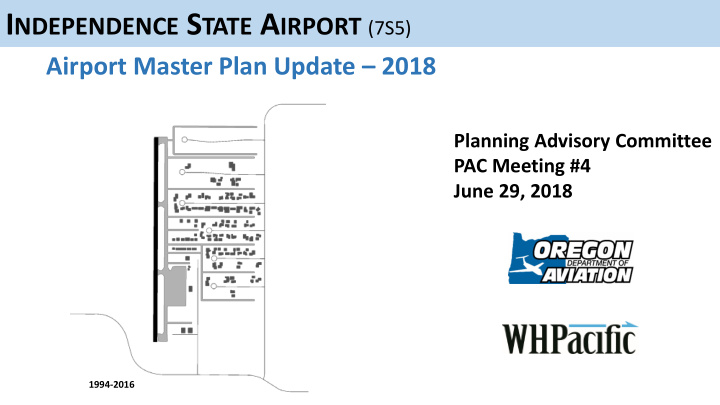



I NDEPENDENCE S TATE A IRPORT (7S5) Airport Master Plan Update – 2018 Planning Advisory Committee PAC Meeting #4 June 29, 2018 1994-2016
A GENDA The Fourth PAC workshop will cover the following topics: Recap of Planning Team/PAC Roles and Responsibilities Role and Forecast Summary Alternative Scenario Summary Final Three Alternative Concepts Group Discussion Public Comments Next Steps Public Open House
PAC R OLES AND R ESPONSIBILITIES The PAC is an advisory committee to the State, the State has final authority over the Master Plan PAC Members should: Provide input Share ideas Express concerns Help disseminate accurate information about the plan to the public
C ONSULTANT R ESPONSIBILITIES The PAC is an advisory committee to the State, the State has final authority over the Master Plan Consultant should: Facilitate meetings – Keep them on-topic and moving forward… Develop meeting materials Listen to public stakeholders Serve as a technical expert Develop narrative reports and documents for review and approval
E LEMENTS OF A M ASTER P LAN This Airport Master Plan consists of 11 essential elements 1. Public Involvement 2. Project Introduction 3. Issues and Opportunities 4. Existing Conditions 5. Aeronautical Activity Forecast 6. Facility Goals and Requirements 7. Airport Development Alternatives Analysis 8. Recycling and Solid Waste Management Plan 9. Airport Layout Plan Drawing Set 10. Implementation Plan (Capital Improvement Plan) 11. AGIS Survey
P ROJECT S CHEDULE
GA National Trends (2017-2037) Expected to Grow: Turboprop/Turbojet (1.4%/2.3%) Helicopter (1.6%) Experimental Aircraft (1%) Sport Aircraft (4.1%) Aircraft Utilization Expected to Decline: Piston Fixed-wing (-0.8%) Piston Utilization Things to Consider: Class III Med. Reform AVgas Replacement Electric/Hybrid Technologies Growing Sport A/C Market Growing Business A/C Market
F ORECAST S UMMARY
A LTERNATIVE S CENARIO S UMMARY Three draft concepts prepared Each meet facility requirements for future growth Incorporate and address key issues where able Turf runway/alternate landing area o Long range development on west side o Flexible for meeting B-II (larger aircraft) in the future o Stormwater/drainage reserve areas o
A LTERNATIVES P ROCESS Two-step selection • process Choose among an array • of alternative options Integrated with Public • Participation Results in “Preferred • Alternative” for further study, documentation, and implementation
E XISTING C ONDITIONS FAA Design Standards to be addressed Area Information Airport History & Role Community Data Hoffman Road through Relevant Studies Runway Protection Zone Environmental Data Landside Land Use Utilities/Drainage Security, Access, & Parking GA Terminal Area TTF, HOA, and Hangars Airside Airside Facilities Aligned Taxiway FAA Design Standards Requires Removal Airspace Admin/Policies/Ops 8.035 Acre - Visual Airport Administration Runway Protection Zone Airport Financials Aviation Activity / Forecasts
R UNWAY P ROTECTION Z ONES FAA considers roads to be an • incompatible land use within an RPZ Existing non-conforming use • “grandfathered” Compliance required if RPZ is • changed Options: Shift runway north or • realign Hoffman Rd – Shift north for B-II would result in less than 3,000-ft runway – Realignment options shown – $20M cost
A LTERNATIVE O NE - F EATURES
A LTERNATIVE T WO - F EATURES
A LTERNATIVE T HREE - F EATURES
D ISCUSSION AND R EPORT O UT 1. What are key advantages or drawbacks to each alternative? 2. Do you believe any facilities are missing or underrepresented? 3. Do you believe any facilities that FAA would not financially support would be worth local investment? 4. Which alternative best represents your vision for the airport?
P UBLIC C OMMENTS Three minutes for each speaker
N EXT S TEPS PAC #4 and Open House June 2018
P UBLIC C OMMENTS www.Independence-Airport-Master-Plan.com Matt Maass Matthew.D.Maass@aviation.state.or.us Dave Nafie dnafie@whpacific.com Jeff Caines Jeff.Caines@aviation.state.or.us
Recommend
More recommend